Carver County, Minnesota
Sphingidae Larvae
|
|
Updated as per James P. Tuttle's The Hawk Moths of North America, August 16, 2011 Updated as per BAMONA, August 16, 2011 Dedicated to Amy Anderson, September 3, 2013 |
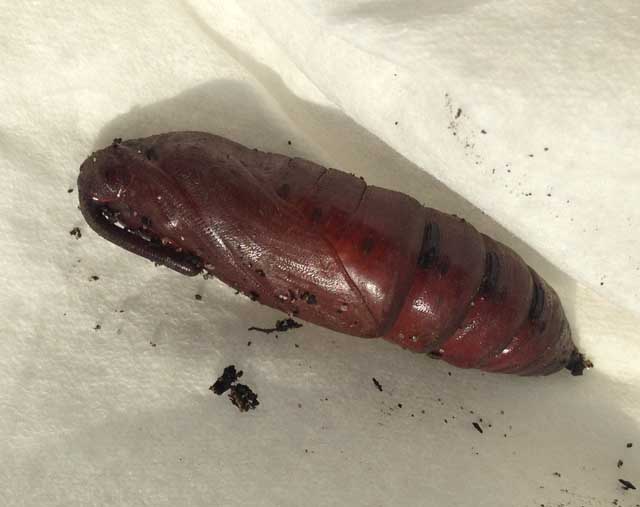
This page is dedicated to Amy Anderson who provides the Sphinx chersis pupa image at the top of the page.
Amy writes, August 29, 2013, "I have been online for more than a week searching for expertise on this. and I hope you can help me. We live in Minnesota, USA.
"We found a large (4-inch or so), bright green caterpillar on our house sidewalk. I put it in a bug keeper (a mesh-sided case for butterflies and caterpillars).
I searched online for food sources, and when assumed it was a Great Ash Sphinx, I put some branches from our ash tree as well as some garden kale and greens, etc.,
just in case.
"I then read about a sphinx burrowing in the dirt. I filled a smaller bug container (4inch x 6inch x 4inch) with dirt and put it in the larger container with the
caterpillar. Caterpillar walked around, explored all sticks and plants for a few hours while I observed off and on. Wanted to be sure I provided for its needs
while we observed it for the short time I planned on keeping it.
"When I went back to the container, the caterpillar was nowhere. I found a hole in the black dirt. I assume it burrowed in the pupate. I am concerned that I am
now caring for this and I am unsure exactly what it is or what it needs. I have found some info online stating a sphinx will pupate in two weeks. Another says
overwinter. We are in Minnesota and it is currently very very hot here as it is August. I do not want the caterpillar to overheat in the small container, nor do
I want to disturb it. I do not know if I should leave it outside or bring it in, or for how long.
"The caterpillar we found is nearly identical to the one that I found from your website. Sadly, I did not get a photo of ours because it burrowed so soon.
"Can you please advise on the best way to care for this caterpillar?"
I reply, "Your caterpillar excavated a tunnel in the earth you provided. It will shed its skin inside the “underground” tunnel/chamber. The
process of shedding its skin is called pupation. The new form that will exist is call a pupa.
"Pupation usually takes place within a week of caterpillar going underground. I suggest you wait ten days from disappearance date, and then carefully unearth the
pupa and treat as per the "Fore Care of Found caterpillars" article. I am pretty sure this one is going to overwinter in pupa stage."
Amy asked for some clarification and asked additional questions.
I reply, "Yes, you should dig up the pupa, and the you should follow the instructions below:
"The naked pupa should be deposited gently on top of the dry paper towels, but wait a couple more days (leave pupa where it is for now), probably three or four
to give the pupal shell a chance to thoroughly harden.
"When the adult moth does emerge from the pupa, its wings will be very soft and crumpled. It needs to be able to climb and hang so that fluids can be pumped into
wing veins for proper expansion of wings. It is a good idea to have a paper towel, draped over sides of container, top to bottom, so emerged moth can climb
towelling to hang. You will probably want to watch this process, so just drape towel over sides of one half of the container with bottom of draped towel under
towelling on bottom of container, or place a stick, pencil-thick, on a diagonal from bottom to top of container so moth can hang from that.
"If the moth has not emerged within five to six weeks you should do the refrigerator crisper step. I am pretty sure the moth is not going to emerge this
summer/fall but it is best to wait and see, so do not refrigerate until five or six more weeks have passed. You can wait even longer if you like. I usually do
the next step in October with my pupae here on PEI..
"I would not leave the container with the pupa out on the front step. If there is rain and cover is porous, the container might get flooded. If there is no
rain and it is hot, the soil might bake and the pupa might overheat. I would bring the container indoors but put a non-porous container over top of it so the
soil does not lose its natural moisture and the pupa does not desiccate. Good job you told me about the air conditioner which tends to suck moisture out of
the air, and would even cause the pupa to possibly desiccate if not in a closed, non-porous container."
Hopefully Amy and her family wil get to see the emergent moth either this fall or, more likely, next spring/summer.
Thirty-seven Sphingidae species are listed for Minnesota on the BAMONA
website as of August 16, 2011. Not all of the species are reported or anticipated in Carver County (None are reported
on BAMONA as of August 16, 2011). It is hoped that this checklist, with the thumbnails and notes, will help you quickly identify the Sphingidae larvae you are
likely to encounter.
A "WO" after the species name indicates that I have no confirmed reports of this species in your county, but I
(William Oehlke) expect that this moth with its larvae are present or might be present. I have included many species not on the
BAMONA list for Minnesota; I believe they are or might be present
A "BAMONA" indicates the moth is reported in Lepidoptera of North America, #1. Distribution of Silkmoths (Saturniidae) and
Hawkmoths (Sphingidae) of Eastern North America, an excellent little booklet available through Paul Opler.
Please help me develop this list with improved, documented accuracy by sending sightings (species, date, location), preferably with an
electronic image, via email to Bill Oehlke.
Please also report any sightings to BAMONA, an excellent online resource, via links in header or to the left.
The larvae
are much more spectacular than the moths. Catalpa is the larval host. Larvae feed primarily on lilac and fringe.
Larvae feed on poplars and cottonwood.
Larvae are green until the final instar.
Enjoy some of nature's wonderments, giant silk moth cocoons.
These cocoons are for sale winter and fall. Beautiful Saturniidae moths will emerge the following spring and summer.
Read Actias luna rearing article. Additional online help available.
Use your browser "Back" button to return to the previous page.
This page is brought to you by Bill Oehlke and the
WLSS. Pages are on space rented from Bizland. If you would like to become a "Patron of the Sphingidae Site", contact Bill.
Please send sightings/images to Bill. I will do my best to respond to requests for identification help.
Sphinginae subfamily

Ceratomia amyntor WO, Elm Sphinx, Four-horned Sphinx:
Elm (Ulmus), birch (Betula), basswood (Tilia), cherry (Prunus).
Both green and brown forms. Four horns near head are diagnostic.

Ceratomia catalpae WO, Catalpa Sphinx:
This caterpillar is one of the few North American Sphingidae that
feed in large groups. Colouration is distinctive.

Ceratomia undulosa WO, Waved Sphinx: Fraxinus, Ligustrum, Quercus, Crataegus and
Chionanthus virginicus are listed as hosts. In the fifth instar, spiracular ovals are decidedly red and anal horn is off-white to pinkish laterally.

Lapara bombycoides WO, Northern Pine Sphinx:
This caterpillar is also without the anal horn and feeds on pines.
The long stripes and reddish brown afford great camouflage.

Lintneria eremitus
WO, Hermit Sphinx: Note triangular bump on the thorax.
Beebalm (Monarda), mints (Mentha), bugleweed (Lycopis), sage (Salvia).

Manduca quinquemaculatus WO, Five-spotted Hawkmoth: Tomato Hornworms: black horn at end of abdomen.
Larvae feed on potato, tobacco, tomato, and other plants in nightshade family (Solanaceae).

Manduca sexta WO, Carolina Sphinx:
Note red horn and black dots anterior to white oblique lines.
If you grow tomatoes, you have probably encountered it. generally more southerly
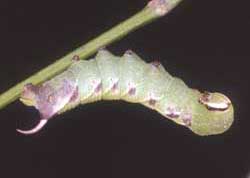
Sphinx canadensis WO, Canadian Sphinx: Uncommon at lights, not
often reported anywhere. Larval host may be exclusively black ash (Fraxinus nigra).
Variable appearance but always with granulous (darker protrusions) on pinkish horn.
Sphinx chersis prepupal larva, August 29, 2013, Amy Anderson
Sphinx chersis AA, Northern Ash Sphinx Great Ash
Sphinx: Pale bluish green. Head: pair of yellow lateral bands meeting at apex. Oblique, lateral stripes:
pale, bordered anteriorly with darker green. Ash, lilac, privet, cherry, quaking aspen.

Sphinx drupiferarum WO, Wild Cherry Sphinx:
Larvae hide by day, feed primarily on cherry, plum, apple at night. Amelanchier nantuckensis
in Massachusetts; Michigan: Prunus serotina. Note purple oblique lines.

Sphinx gordius WO, Apple Sphinx:
Apple (Malus), sweetfern (Myrica), Carolina rose (Rosa carolina), blueberry and huckleberry
(Vaccinium), white spruce (Picea glauca), American larch (Larix laricina), alder (Alnus).

Sphinx kalmiae
WO, Laurel Sphinx:
In the final instar, the black on the head, lateral lines, horn and on abdominal
legs is diagnostic.
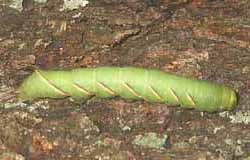
Sphinx luscitiosa WO ??, Canadian Sphinx, Clemen's Sphinx:
Willow (Salix), poplar (Populus), birch (Betula), apple (Malus), ash (Fraxinus), waxmyrtle (Morella), northern bayberry.
generally more northerly
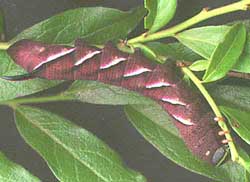
Sphinx poecila WO, Poecila Sphinx:
If you have blueberries in the woods, then you probably have the Poecila Sphinx.
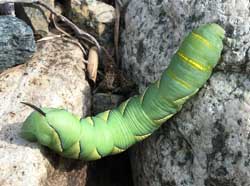
Sphinx vashti WO ??, Snowberry Sphinx:
Snowberry (Symphoricarpos albus), coralberry (S. orbiculatus). Note two golden
lines of slightly raised bumps, one just behind head, other
on thorax. generally more westerly
Smerinthini Tribe:

Amorpha juglandis WO, Walnut Sphinx:
Amorpha juglandis larvae feed upon Walnut and butternut (Juglans),
hickory (Carya), alder (Alnus), beech (Fagus),
hazelnut (Corylus), and hop-hornbeam (Ostrya).

Pachysphinx modesta
WO,
the Modest Sphinx or Poplar Sphinx

Paonias excaecata
WO,
the Blinded Sphinx:
Larvae accept willows, birches, and cherries.
I have also found them in the wild on oak in eastern Canada.

Paonias myops WO, Small-eyed Sphinx:
Wild cherry species are the favorites as larval foodplants, but eggs
will also be deposited on birches and other forest trees.
There are varying degrees in the amount of red markings along the sides.

Smerinthus cerisyi WO, Cerisy's Sphinx; Pale green, granular skin, pale lateral diagonal lines, faint
red spiracular circles, very pale longitudinal lines running from head to more pronounced anal diagonal line. Green heads bounded dorsally with pale yellow
inverted V.

Smerinthus jamaicensis WO, Twin-spotted Sphinx:
Larvae feed upon many forest trees including birches and cherries, but are expecially fond of poplars and willows. Red markings on sides
vary greatly from specimen to specimen.
Macroglossinae subfamily
Dilophonotini tribe:
See Hemaris comparisons.

Hemaris diffinis WO, Snowberry Clearwing:
Snowberry (Symphoricarpos), honeysuckle (Lonicera), Coralberry, viburnums, Blue Dogbane
(Apocynum), dwarf bush honeysuckle (Diervilla lonicera).
Horn: black, yellow base.

Hemaris thysbe
WO, the Hummingbird Clearwing:
There is also an orangey-pink prepupal form. The lateral line runs
from S1 to the blue horn.
Hemaris thysbe larvae feed on viburnum and related plants.
Philampelini Tribe:

Eumorpha achemon WO, Achemon Sphinx: Grape (Vitis), Virginia Creeper
(Parthenocissus quinquefolia), other vines, ivies (Ampelopsis).
light (green) form; darker (tan/brown)
form. Note six "segmented" oblique lines.

Eumorpha pandorus
WO, Pandorus Sphinx:
If you have Grape or Virginia Creeper nearby, then you might encounter
this species. Note five large white ovals. There are
orangey-brown and green
forms also.
Macroglossini tribe:

Amphion floridensis WO, Nessus Sphinix:
In additon to Virginia creeper larvae accept Grape (Vitis), ampelopsis (Ampelopsis), and cayenne pepper (Capsicum).

Darapsa choerilus WO, Azalea Sphinx: Azalea, Viburnum; progress very rapidly.
Larva to left on Viburnum cassinoides is getting ready to pupate. Color change from green to light burgundy-brown indicates pupation near.

Darapsa myron WO, Virginia Creeper Sphinx, Grapevine Sphinx:
If you have foodplants indicated in common names, you probably have this
species nearby. Lower wings: orange.
Virginia creeper (Parthenocissus quinquefolia),
Grape (Vitis), Ampelopsis, Viburnum.

Deidamia inscriptum WO, Lettered Sphinx:
Grape (Vitis), ampelopsis (Ampelopsis), Virginia creeper (Parthenocissus).
The alternating yellow and greyish-green rings across the back distinguish this larva.
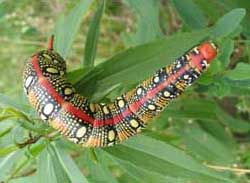
Hyles euphorbiae WO, Leafy Spurge Hawk Moth
Leafy spurge. Conspicuously colored, with pronounced tail or "horn" near rear end. Young larvae variously patterned with green, yellow, black;
older larvae have distinctive red, black, yellow, white color pattern. Mature larvae may approach 10 cm in length; when disturbed,
they regurgitate a slimy green liquid.

Hyles gallii
WO, Bedstraw Hawk Moth, Gallium Sphinx: I suspect it is present. Larvae come in black and in brown forms and often feed on
Epilobium (fireweed).

Hyles lineata
WO, White-lined Sphinx:
Highly varied. Willow weed (Epilobium), four o'clock (Mirabilis),
apple (Malus), evening primrose (Oenothera), elm
(Ulmus), grape (Vitis), tomato (Lycopersicon),
purslane (Portulaca), Fuschia.
All have red/black swellings split by dorso-lateral lines.

Sphecodina abbottii
WO,
Abbott's Sphinx:
Larvae feed at night on grape (Vitis); ampelopsis
(Ampelopsis); hide on bark of their host plants during
day. Virginia creeper would also be a suitable host. Dark form
without the green patches. Note "raised eye", replacing the anal horn.


Show appreciation for this site by clicking on flashing butterfly to the left.
The link will take you to a page with links to many insect sites.